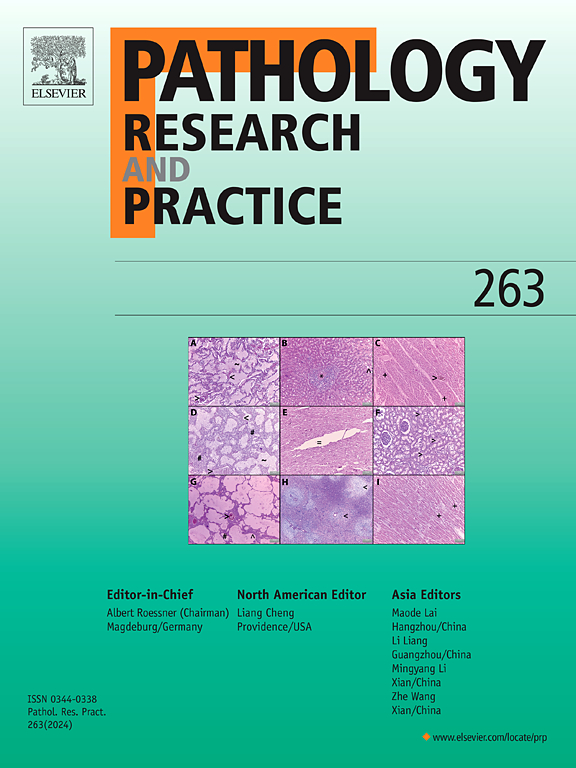法瑞罗通过抑制 TGF-β1/Smad2/3 信号传导抑制肝细胞癌的上皮-间质转化
IF 2.9
4区 医学
Q2 PATHOLOGY
引用次数: 0
摘要
背景:上皮细胞-间质转化(EMT)是包括肝细胞癌(HCC)在内的多种恶性肿瘤转移的重要过程。远志酚是一种植物黄酮类化合物,具有显著的药理作用。然而,远志酚的抗癌活性尚未完全阐明。在此,我们研究了远志酚对 HCC 进展的影响:方法:通过伤口愈合和转基质试验评估了远志酚防止 HCC 细胞迁移和侵袭的潜力。免疫印迹、免疫荧光和 qPCR 被用来检测 EMT 相关蛋白的水平。用转化生长因子β(TGF-β)(10 ng/ml)刺激 HCC 细胞,然后测量细胞迁移、侵袭性和 EMT。免疫印迹法检测了 TGF-β1/Smads 信号传导。采用异种移植小鼠模型评估法罗洛尔在体内的抗癌效果。免疫印迹法或免疫组化法评估了异种移植瘤中EMT和血管生成相关蛋白的表达水平:结果:我们发现法乐洛尔能阻止 HCC 细胞的迁移和侵袭。结果:我们发现法雷罗能阻断 HCC 细胞的迁移和侵袭性。法雷罗能上调 E-cadherin 水平,降低 N-cadherin 和波形蛋白水平。法罗洛尔还能降低 EMT 相关转录因子(包括 slug、snail、twist 和 zeb1)的表达水平。此外,法罗洛尔还能抑制 TGF-β 刺激的 HCC 细胞迁移、侵袭性和 EMT。法罗洛尔抑制了 TGF-β 诱导的 Smad 2/3 磷酸化。重要的是,法勒洛尔能抑制 HCC 在体内的生长和 EMT。法罗洛尔还通过抑制体内缺氧诱导因子-1α(HIF-1α)和血管内皮生长因子(VEGF)来抑制肿瘤血管生成:总之,远志酚通过抑制迁移、侵袭性、EMT和血管生成来抑制HCC,这意味着远志酚可能是一种很有前途的HCC抗转移剂。本文章由计算机程序翻译,如有差异,请以英文原文为准。
Farrerol suppresses epithelial-mesenchymal transition in hepatocellular carcinoma via suppression of TGF-β1/Smad2/3 signaling
Background
Epithelial-mesenchymal transition (EMT) is an essential process for the metastasis of multiple malignancies, including hepatocellular carcinoma (HCC). Farrerol is a plant-derived flavonoid and has significant pharmacological effects. However, the anticancer activities of farrerol have not been fully elucidated. Here, we investigated the effects of farrerol on HCC progression.
Methods
The potential of farrerol to prevent HCC cell migration and invasiveness was evaluated by wound healing and transwll matrix assays. Immunoblotting, immunofluorescence, and qPCR were used to detect the levels of EMT-related proteins. Transforming growth factor beta (TGF-β) (10 ng/ml) was used to stimulate HCC cells, followed by measurement of cell migration, invasiveness, and the EMT. TGF-β1/Smads signaling was examined by immunoblotting. A xenograft mouse model was used to assess the anticancer efficacy of farrerol in vivo. The expression levels of EMT- and angiogenesis-related proteins in xenograft tumors were evaluated by immunoblotting or immunohistochemistry.
Results
We found that farrerol blocked HCC cell migration and invasiveness. Farrerol upregulated E-cadherin levels and reduced N-cadherin and vimentin levels. Farrerol also downreuglated the expression levels of EMT-related transcription factors including slug, snail, twist, and zeb1. Furthermore, farrerol suppressed TGF-β-stimulated migration, invasiveness, and the EMT in HCC cells. The phosphorylation of Smad 2/3 induced by TGF-β was inhibited by farrerol. Importantly, farrerol suppressed HCC growth and the EMT in vivo. Farrerol also inhibited tumor angiogenesis by inhibiting hypoxia-inducible factor-1 alpha (HIF-1α) and vascular endothelial growth factor (VEGF) in vivo.
Conclusion
Overall, farrerol suppresss HCC by inhibiting migration, invasiveness, the EMT, and angiogenesis, implying that farrerol could be a promising antimetastasis agent for HCC.
求助全文
通过发布文献求助,成功后即可免费获取论文全文。
去求助
来源期刊
CiteScore
5.00
自引率
3.60%
发文量
405
审稿时长
24 days
期刊介绍:
Pathology, Research and Practice provides accessible coverage of the most recent developments across the entire field of pathology: Reviews focus on recent progress in pathology, while Comments look at interesting current problems and at hypotheses for future developments in pathology. Original Papers present novel findings on all aspects of general, anatomic and molecular pathology. Rapid Communications inform readers on preliminary findings that may be relevant for further studies and need to be communicated quickly. Teaching Cases look at new aspects or special diagnostic problems of diseases and at case reports relevant for the pathologist''s practice.

 求助内容:
求助内容: 应助结果提醒方式:
应助结果提醒方式:


